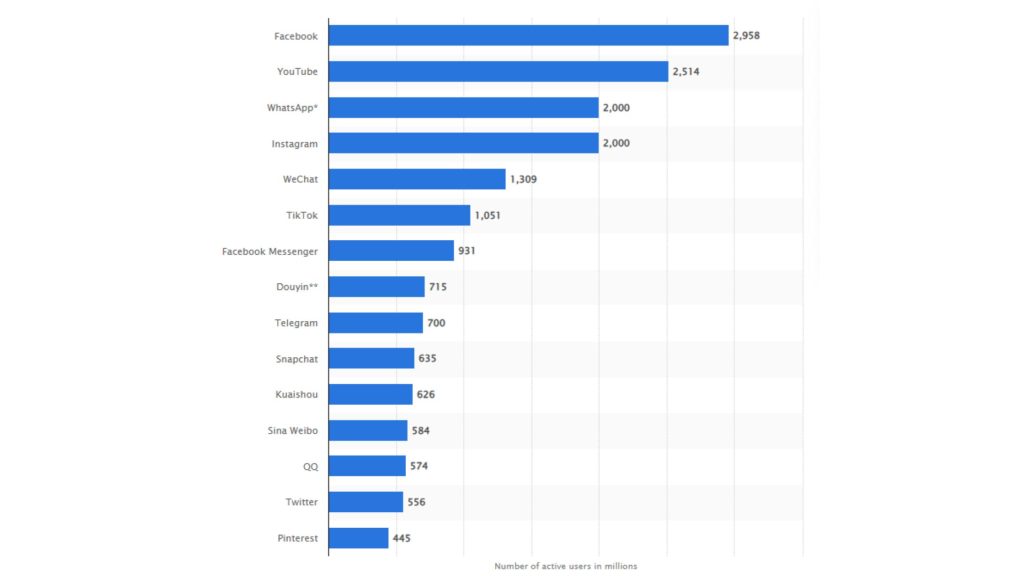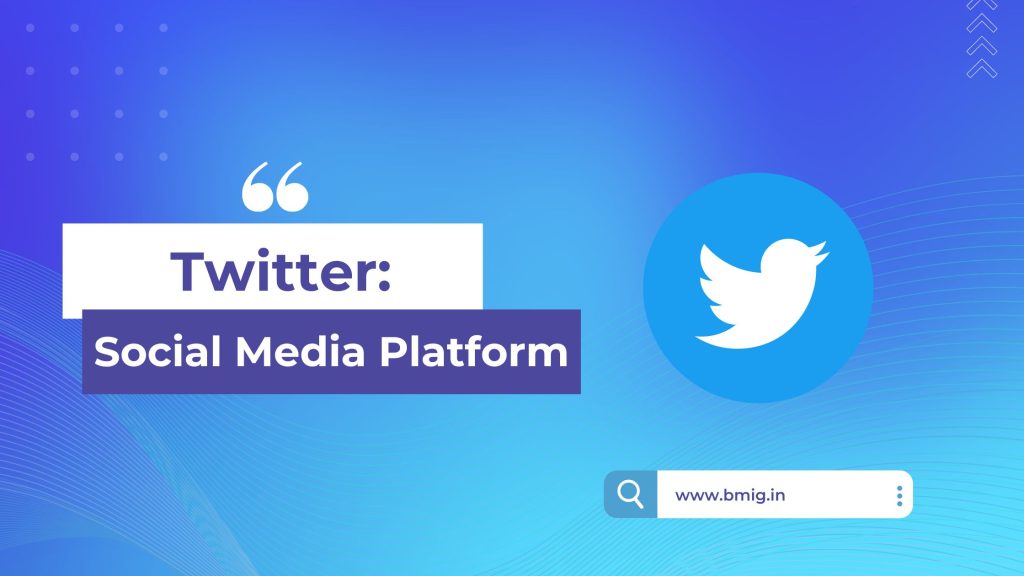Social media has become an integral part of our lives, shaping how we connect, communicate, and share information. With the rapid advancements in technology and the increasing accessibility of the internet, a multitude of social media platforms have emerged, each catering to different interests, demographics, and purposes. In this overview, we will delve into seven of the most popular social media platforms, exploring their unique features, functionalities, and impact on society.
Before that, lets have a look at the number of monthly active users of each social media platform. This will give us a clear idea of popularity of each platform:

| Platform | Monthly Active Users |
|---|---|
| 2958 | |
| YouTube | 2514 |
| 2000 | |
| 2000 | |
| 1309 | |
| TikTok | 1051 |
| Facebook Messenger | 931 |
| Duoyin | 715 |
| Telegram | 700 |
| Snapchat | 635 |
Understanding the Social Media Landscape
Social media platforms are essentially online spaces where individuals and communities can create, share, and exchange content. They facilitate the building of social networks and relationships, enabling users to connect with people across geographical boundaries.
Types of Social Media Platforms: Social media platforms can be broadly categorized based on their primary function:
- Social Networking Sites: Focus on connecting people (e.g., Facebook).
- Microblogging Platforms: Short-form content sharing (e.g., X).
- Photo and Video Sharing Platforms: Visual content (e.g., Instagram, TikTok, Pinterest).
- Professional Networking Platforms: Career-oriented connections (e.g., LinkedIn).
- Forums and Discussion Boards: Community-based discussions (e.g., Reddit).
The 7 Social Media Platforms
1. Facebook
- What it is: The largest social networking platform, connecting billions of users worldwide.
- Key Demographics: Diverse, spanning almost all age groups and demographics.
- What it’s Used For: Connecting with friends and family, sharing personal updates, joining groups, following brands and businesses.
- Statistics: Boasts billions of monthly active users.
- Pros: Wide reach, diverse content, established platform.
- Cons: Privacy concerns, algorithm changes affecting organic reach.
- Examples: Brands use Facebook for advertising, community building, and customer service.
- Future trends: Focus on metaverse integration and community-driven features.
Facebook is undeniably one of the top social media platforms in the world, with an immense user base and a significant influence on how people connect and engage online.
Key Statistics about Facebook
- 98.5% / 2.8 billion access Facebook through mobile devices like phones and tablets
- 81.8% / 2.33 billion access Facebook only through a mobile phone
- 16.7% / 476 million access Facebook through phones and computers
- 1.5% / 43 million access Facebook only through a laptop or desktop computer
- 94% of Facebook Ad revenue is from mobile, leaving 6% through a desktop.
- The average time spent on Facebook per day is 33 minutes
2. X (Previously Twitter)
X (Twitter) is a popular social media platform known for its real-time, concise nature and its ability to facilitate rapid information sharing. With its character limit of 280 characters per tweet, Twitter encourages users to express their thoughts, share updates, and engage in public conversations. The platform’s unique features and wide reach make it a valuable tool for marketing and promoting businesses.

- What it is: A microblogging platform for real-time updates, news, and discussions.
- Key Demographics: Journalists, politicians, celebrities, and individuals interested in current events.
- What it’s Used For: Sharing short messages (tweets), following news and trends, engaging in public conversations.
- Statistics: Features millions of daily active users.
- Pros: Real-time information, direct engagement with public figures, easy to stay updated on current events.
- Cons: Character limit, potential for misinformation, can be overwhelming.
- Examples: News outlets use X to share breaking news, brands use it for customer service and real-time marketing.
- Future trends: Focus on becoming an “everything app” with diverse features beyond microblogging.
Key Statistics about Twitter
- Users aged 18-34 like Twitter the most out of all generations
- Twitter is the most popular social platform for news and current events
- People spend an average of 4.4 hours per month on Twitter
- As of the second quarter of 2022, Twitter had 237.8 million monetizable daily active users (mDAU). Source
3. Instagram
A photo and video-sharing platform that is popular among young people and celebrities. It allows users to share pictures and videos, as well as apply filters and effects to them.
- What it is: A photo and video-sharing platform focused on visual content.
- Key Demographics: Young people and celebrities.
- What it’s Used For: Sharing pictures and videos, applying filters and effects.
- Statistics: Has 1.6 billion monthly active users as of 2025.
- Pros: Visually appealing, large user base, strong influencer culture.
- Cons: Can be superficial, algorithm changes affecting organic reach.
- Examples: Influencers use Instagram to showcase their lifestyle and promote products, brands use it for visual marketing.
- Future trends: Increased focus on short-form video content (Reels) and e-commerce integration.
4. TikTok
A video-sharing platform that has gained popularity in recent years, particularly among young people. It allows users to create and share short videos set to music or other audio.
- What it is: A video-sharing platform known for short-form, entertaining content.
- Key Demographics: Young people, especially Gen Z.
- What it’s Used For: Creating and sharing short videos set to music or other audio.
- Statistics: As of 2025, it has 954 million monthly active users.
- Pros: High engagement, viral potential, creative content format.
- Cons: Concerns over data privacy, potential for addictive content.
- Examples: Brands use TikTok for viral marketing campaigns and engaging with younger audiences.
- Future trends: Focus on e-commerce, augmented reality filters, and expansion into longer-form video content.
5. LinkedIn
A professional networking platform that is popular among business professionals and job seekers. It allows users to connect with others in their industry, share content, and find job opportunities.
- What it is: A professional networking platform for career-oriented connections.
- Key Demographics: Business professionals and job seekers.
- What it’s Used For: Connecting with others in their industry, sharing content, and finding job opportunities.
- Statistics: Has 310 million monthly active users15. The average user has about 930 connections.
- Pros: Professional networking, job opportunities, business development.
- Cons: Can be formal, less personal than other platforms.
- Examples: Recruiters use LinkedIn to find talent, professionals use it to build their network and showcase their expertise.
- Future trends: Focus on skills-based hiring, online learning, and professional development resources.
6. Pinterest
Pinterest: A platform that allows users to share and discover new ideas by “pinning” images and videos to virtual boards. It is popular for topics such as fashion, home decor, and recipes.
- What it is: A visual discovery platform where users “pin” images and videos to virtual boards.
- Key Demographics: Women, people interested in DIY, home decor, fashion, and recipes.
- What it’s Used For: Discovering and saving ideas, planning projects, finding inspiration.
- Statistics: Features 417 million monthly active users.
- Pros: Visually appealing, great for inspiration and planning, strong e-commerce potential.
- Cons: Limited organic reach, copyright issues.
- Examples: Brands use Pinterest to showcase their products, users use it to plan weddings and home renovations.
- Future trends: Enhanced visual search capabilities, augmented reality tools for shopping.
7. Reddit
Reddit: A social news and discussion platform that allows users to submit and vote on content, such as links and text posts. It is organized into communities called “subreddits” that focus on specific topics.
- What it is: A social news and discussion platform organized into communities called “subreddits.”
- Key Demographics: Diverse, spanning various interests and hobbies.
- What it’s Used For: Submitting and voting on content, participating in discussions, finding niche communities.
- Statistics: Boasts millions of active users and subreddits.
- Pros: Diverse content, strong community focus, platform for niche interests.
- Cons: Can be toxic, potential for misinformation, requires moderation.
- Examples: Users participate in discussions on their favorite topics, brands engage with specific communities.
- Future trends: Focus on community building, content moderation, and monetization for creators.
Choosing the Right Platform for You
Selecting the right social media platform depends on your specific goals and target audience. Consider the following:
- Audience: Which platform is your target audience most active on?
- Content Type: What type of content do you want to share (visual, text-based, video)?
- Goals: What do you want to achieve (brand awareness, lead generation, community building)?
It’s often beneficial to explore multiple platforms to find the best fit for your needs.
Conclusion
The social media landscape offers a plethora of platforms, each with its unique features and user base. Staying informed about these platforms is crucial for individuals and businesses alike. By understanding the strengths and weaknesses of each platform, you can strategically leverage them to achieve your goals. Don’t be afraid to experiment and adapt your social media strategy as the digital world continues to evolve.

